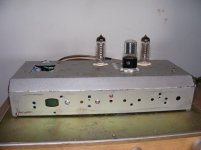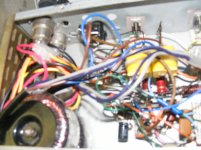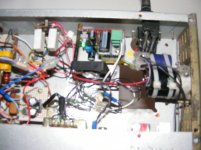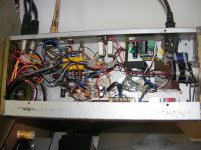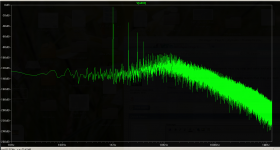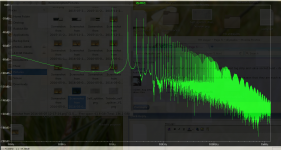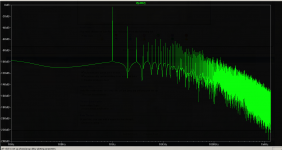OK here are the photo's I promised.
Things worthy of note
-the CCS are built onto small squares of perf board and then simply bolted to the case with insulators. Enough heatsink to keep them cool even on a steel case.
-both the output transformers are stacked with a single bolt holding them under the case. The remarkable powers of toroidals means that there is no detectable crosstalk as a consequence.
-each valve has its own tag strip and it would be challenging to build this point to point without a tag strip.
-the screen supply has its own board with the large pot. The bias supply has its own little board and transformer (now redundant) which could be built onto a single board of little over 2inchs square.
-the boost converter doesn't need its fan as it only gets warm to the touch at these current draws.
-the cap could be smaller, but its what I had in the parts bin. Its not there to smooth the voltage which is ruler flat as it is, its there to isolate the boost converters sonic signature.
As you might have guessed this build was not an exercise in neatness, but despite the mess of wires it has no noise issues and illustrates that a logical approach to building is more important than an anal retentive approach to neatness.
Will be running more side by side simulations later today for a definitive comparison of distortion at realistic sound levels.
Shoog
Things worthy of note
-the CCS are built onto small squares of perf board and then simply bolted to the case with insulators. Enough heatsink to keep them cool even on a steel case.
-both the output transformers are stacked with a single bolt holding them under the case. The remarkable powers of toroidals means that there is no detectable crosstalk as a consequence.
-each valve has its own tag strip and it would be challenging to build this point to point without a tag strip.
-the screen supply has its own board with the large pot. The bias supply has its own little board and transformer (now redundant) which could be built onto a single board of little over 2inchs square.
-the boost converter doesn't need its fan as it only gets warm to the touch at these current draws.
-the cap could be smaller, but its what I had in the parts bin. Its not there to smooth the voltage which is ruler flat as it is, its there to isolate the boost converters sonic signature.
As you might have guessed this build was not an exercise in neatness, but despite the mess of wires it has no noise issues and illustrates that a logical approach to building is more important than an anal retentive approach to neatness.
Will be running more side by side simulations later today for a definitive comparison of distortion at realistic sound levels.
Shoog
Attachments
Last edited:
OK here are the photo's I promised.
As you might have guessed this build was not an exercise in neatness, but despite the mess of wires it has no noise issues and illustrates that a logical approach to building is more important than an anal retentive approach to neatness.
Shoog
Not an exercise in neatness? Shoog your build here makes my "quite good and I am satisfied I have most of my fingers still intact" builds look bad. I look at it and I can learn something here, you know. I mean it is close to to George's/Tubelab's on wood and alligator clip wiring missions, but still much better than mine.
Nice work.
Under all that spaghetti there is an extremely neat tag strip and valve socket build - its just a shame you just can't see it 
All joking aside though, I do like neat builds for the simple reason that they are much easier to fault find when they go wrong.
Shoog
All joking aside though, I do like neat builds for the simple reason that they are much easier to fault find when they go wrong.
Shoog
Last edited:
OK comparison at 1W.
I don't think I need to carry on, but if anyone want to run their own simulations for comparison be my guest. I could have made some gross error which someone else might spot. However I don't think I have and these results seem to confirm what myself and others have reported regarding the RH designs.
Let me say my amp design is not a stellar performer in of itself (I said from the outset that it was not a low distortion design), but its leagues ahead of the RH84.
What people forget it is that most of the time amps (especially low powered Valve amps) will spend most of their life at subwatt levels where their distortion is fairly small and they sound OK and this is why most users will remain happy with designs that on empirical evidence should be reporting as awful.
Shoog
I don't think I need to carry on, but if anyone want to run their own simulations for comparison be my guest. I could have made some gross error which someone else might spot. However I don't think I have and these results seem to confirm what myself and others have reported regarding the RH designs.
Let me say my amp design is not a stellar performer in of itself (I said from the outset that it was not a low distortion design), but its leagues ahead of the RH84.
What people forget it is that most of the time amps (especially low powered Valve amps) will spend most of their life at subwatt levels where their distortion is fairly small and they sound OK and this is why most users will remain happy with designs that on empirical evidence should be reporting as awful.
Shoog
Attachments
Last edited:
Shoog, I have nothing but respect for you and the innovative designs I've seen you post.
I think one element of the RH84 that has lead to its popularity is the simplicity of the amplifier (original without zener and LM317). Aside from the feedback arrangement, it is the kind of tube amp that anyone with a book's worth of rudimentary tube knowledge can follow.
Comparing your design with the RH84 simply on the basis of Schade FB is unfair to both amplifiers. This being DIY, the kind of builder who is intrigued or motivated by one design will be left unmoved (or confused) by the other. It's like comparing a Prius to a Miata (engineering innovation to traditional simplicity).
I hope you don't take this as a slight to your amplifier, but I think the RH84 is still the 'better' design for a novice. As you've shown with measurements, your design clearly betters it for builders that can understand it and take the time with a more complicated amplifier. Don't sell yourself short by setting your benchmark too low.
I think one element of the RH84 that has lead to its popularity is the simplicity of the amplifier (original without zener and LM317). Aside from the feedback arrangement, it is the kind of tube amp that anyone with a book's worth of rudimentary tube knowledge can follow.
Comparing your design with the RH84 simply on the basis of Schade FB is unfair to both amplifiers. This being DIY, the kind of builder who is intrigued or motivated by one design will be left unmoved (or confused) by the other. It's like comparing a Prius to a Miata (engineering innovation to traditional simplicity).
I hope you don't take this as a slight to your amplifier, but I think the RH84 is still the 'better' design for a novice. As you've shown with measurements, your design clearly betters it for builders that can understand it and take the time with a more complicated amplifier. Don't sell yourself short by setting your benchmark too low.
I think one element of the RH84 that has lead to its popularity is the simplicity of the amplifier (original without zener and LM317). Aside from the feedback arrangement, it is the kind of tube amp that anyone with a book's worth of rudimentary tube knowledge can follow.
Comparing your design with the RH84 simply on the basis of Schade FB is unfair to both amplifiers. This being DIY, the kind of builder who is intrigued or motivated by one design will be left unmoved (or confused) by the other. It's like comparing a Prius to a Miata (engineering innovation to traditional simplicity).
I hope you don't take this as a slight to your amplifier, but I think the RH84 is still the 'better' design for a novice. As you've shown with measurements, your design clearly betters it for builders that can understand it and take the time with a more complicated amplifier. Don't sell yourself short by setting your benchmark too low.
+1
The RH84 is what it is. The pity is that the design's original champion was combative instead of collaborative - with the result that the design wound up in some warped parallel universe of insults and hurt feelings instead of enjoying a productive evolution on the forum.
I assembled an RH84 to the original design in the fall of 2009 as my third scratch build. It was a great introduction to single-ended tube amplification without butchering an old Magnavox console amp or selling blood for expen$ive DHT stuff (I did spring for nice James output iron though). I wasn't quite a rank novice, but inexpensive, quick and easy were still important for me at the time as I was just beginning graduate school. That said, it's done its job, and I do think it's time to revisit and rebuild, perhaps with a 6AU6 as a driver (I've got buckets full of 'em).
So thanks for all the hard work, Shoog. I'm excited to see where this one goes.
(And Sodacose: love the website. I was laughing for hours!
The sad fact is that I can drag more clean power out of a single ECL82 with plate to cathode feedback than the RH84 can deliver.
However, on the point of my design, I can say with some certainty that with a tiny bit more effort you can have a better amp at a lower cost than the RH designs - which has got to be a good thing. I got started building an RH807 so can attest that it represents a way of wetting your feet - but what I dislike is Kitics inability to admit the amp for what it actually is - a rather poor little SE amp which mis-applies a good feedback arrangement and actually discredits the work of Schade as a consequence.
Shoog
However, on the point of my design, I can say with some certainty that with a tiny bit more effort you can have a better amp at a lower cost than the RH designs - which has got to be a good thing. I got started building an RH807 so can attest that it represents a way of wetting your feet - but what I dislike is Kitics inability to admit the amp for what it actually is - a rather poor little SE amp which mis-applies a good feedback arrangement and actually discredits the work of Schade as a consequence.
Shoog
Too true. AK's hyperbole and vehement defense of the design did not do it any favors in our hearts, I think. For a simple amp with common tubes, I couldn't find much fault with the one I built. Have I heard better amps? Absolutely. Would I stop building at the RH84? Definitely not.
I'm glad you took the post in the spirit that I intended it, Shoog. I always enjoy your 'outside of the box' concoctions.
And thanks for the compliment, Mr Zenith My site is one part comedy and one part tube primer for the electrically challenged.
My site is one part comedy and one part tube primer for the electrically challenged.
I'm glad you took the post in the spirit that I intended it, Shoog. I always enjoy your 'outside of the box' concoctions.
And thanks for the compliment, Mr Zenith
The sad fact is that I can drag more clean power out of a single ECL82 with plate to cathode feedback than the RH84 can deliver.
However, on the point of my design, I can say with some certainty that with a tiny bit more effort you can have a better amp at a lower cost than the RH designs - which has got to be a good thing. I got started building an RH807 so can attest that it represents a way of wetting your feet - but what I dislike is Kitics inability to admit the amp for what it actually is - a rather poor little SE amp which mis-applies a good feedback arrangement and actually discredits the work of Schade as a consequence.
Shoog
Chance of hundreds of happy RH84 builders worldwide (I’m one of them) enjoying that waterfall (post 44) of odd harmonics – with which *you* imply is what RH84 is about – is zero.
After all, isn’t it (according to numbers-are-everything crowd joined by pp-rules crowd) that what pleases ears of us SE fans is the overwhelming second harmonic combined with the absence of odd/higher harmonics?
That screen creation of yours doesn’t look like SE. It looks like PP.
I purposely say ‘creation of yours’ since this seems to be a case of results being tailored (through models, inputs, parameters) to suit your purpose of yet another attack on Kitic.
Slaying this surely is not. More like an attempted stab in the back.
Chance of hundreds of happy RH84 builders worldwide (I’m one of them) enjoying that waterfall (post 44) of odd harmonics – with which *you* imply is what RH84 is about – is zero.
After all, isn’t it (according to numbers-are-everything crowd joined by pp-rules crowd) that what pleases ears of us SE fans is the overwhelming second harmonic combined with the absence of odd/higher harmonics?
That screen creation of yours doesn’t look like SE. It looks like PP.
I purposely say ‘creation of yours’ since this seems to be a case of results being tailored (through models, inputs, parameters) to suit your purpose of yet another attack on Kitic.
Slaying this surely is not. More like an attempted stab in the back.
Results are being tailored? If you think that is the case, run your own sim, man. He invited others to check his work...
The amplifier as built has an almost exact profile of what an SE amp delivers because essentially that is exactly what it is. The fact that you cannot understand the reason why it behaves as an SE reflects badly on your understanding of circuits rather than my circuit.That screen creation of yours doesn’t look like SE. It looks like PP.
The RH84 looks worse than it maybe is in my simulation because I simply couldn't get it to produce a watt of clean power and so all that waterfall represents the squaring off of the waveform as it clips badly. Look at the lower power graph I shared earlier since it shows that the profile is present to even tiny power levels.
But if you disagree, I have thrown out the challenge - simulate and prove me wrong.We simulate before building so that we know not to build the failed ideas.
As I said before, when I built a little ECL82 amp I started out attempting to apply Schade feedback to that design - but my simulation efforts clearly showed that feedback taken from the pentode plate to a split cathode resistor on the triode offered significantly better power output. It was this that set me to understand that Schade feedback simply isn't the best solution when you are using a triode driver.
Shoog
Last edited:
The amplifier as built has an almost exact profile of what an SE amp delivers because essentially that is exactly what it is.
Shoog
Sidetracking, aren’t you?
That screen creation of yours doesn’t look like SE. It looks like PP.
The above line refers to your screen creation of your model of an RH84 amp, and not to your ‘slayer’ design.
I actually went back and rechecked my RH84 simulation and indeed I had made a mistake. i re-ran the corrected model at 1W again and this is what I got. Better but still not great.
So if you think that simulation result is unreasonable, please do your own.
Shoog
So if you think that simulation result is unreasonable, please do your own.
Unfortunately the problem with your logic is that my supposedly PP design measures more like a SE than the RH84. Bit of a problem that.That screen creation of yours doesn’t look like SE. It looks like PP.
Shoog
Attachments
OK here are the photo's I promised
Shoog
I think it is only fair that you show us photos of your RH84 amp. Since you are comparing one against the other. Hey, I'm from Mizzou and need more convincing.
Last edited:
Shoog said:Unfortunately the problem with your logic is that my supposedly PP design measures more like a SE than the RH84. Bit of a problem that.
Shoog
In my couple posts, so far, I have never addressed your design. All the power to whoever wants to build one. My objections are to your unfounded attack (will it ever end?) on RH84 and its creator.
Shoog said:I actually went back and rechecked my RH84 simulation and indeed I had made a mistake.
This is what I meant when I used word 'tailoring' in my first post. Over the years it's this kind of tailoring and tinkering which is supposed to convince me and a bunch of other happy RH84 builders that somehow we're not right to enjoy the sonics of this design.
I rest my case.
My RH807 was a thing of a long time ago and has gone on to make different things since. It morphed into a Gary Pimm Tabor clone first, an amp I still have in storage and which is an excellent example of a Schaded amp design.I think it is only fair that you show us photos of your RH84 amp. Since you are comparing one against the other. Hey, I'm from Mizzou and need more convincing.
Shoog
I have admitted I made a mistake and have corrected it, it is therefore disingenuous of you to claim that the result has been tailored to shed the RH84 in a bad light. I would like to ask if you could admit that your hero worship is a bit of a mistake ??This is what I meant when I used word 'tailoring' in my first post. Over the years it's this kind of tailoring and tinkering which is supposed to convince me and a bunch of other happy RH84 builders that somehow we're not right to enjoy the sonics of this design.
I rest my case.
Br Cornelius
Shoog said:I would like to ask if you could admit that your hero worship is a bit of a mistake ??
Br Cornelius
Hero? Not at all. I remember how my toob journey started with RH84. I had some questions to ask Kitic and I did. Before long I was treated with quite a bit of arrogance. But so what? Life goes on. Over the years, it’s the actual comparisons to at least a few established SE and PP designs that proved to me, time after time, that RH84 is a keeper.
A note on "Schade" feedback:
O. H. Schade, in his Beam Power Tubes paper, used voltage derived feedback, but it was series fed. He used an interstage transformer to accomplish this, but the result was an output stage with a high input impedance and low output impedance. He could vary the feedback ratio by changing some resistor values. A much simpler way of implementing this same feedback scheme is just a cathode feedback winding (but you can't demonstrate the effect of changing the feedback ratios in a whitepaper without winding several output transformers, which I suspect is the reason Schade didn't just do CFB).
Now, it is common on this forum to refer to voltage derived feedback that is parallel fed (like the RH84 or Shoog's new amp) as "Schade feedback". That's fine as long as we're all on the same page but I don't think it is strictly correct to call it this, since Schade applied the feedback differently. You get the same resulting lowered output impedance and increased linearity but you get an output stage with a low input impedance that requires a much different approach to drive properly.
The amp in Schade's paper wants to see a linear voltage drive, this other type wants linear current drive. The first is easily achieved with a linear triode with a near-horizontal load line, the second with a linear pentode and a near-vertical load line. Pentodes don't typically have as linear a V-to-I characteristics as triodes have V-to-V characteristics, so I have always been a bit wary of the pentode approach. And this is the major drawback of the RH84 circuit. The triode makes a poor V-to-I converter to drive the output stage, which is acting as an I-to-V converter.
Is that a problem? Only if your goal is to minimize distortion, which Shoog has done quite well here for the cost. If you like the sound of the RH84 design, build and listen away.
I think this amp approach is pretty novel for its simplicity and performance. Thanks for sharing.
O. H. Schade, in his Beam Power Tubes paper, used voltage derived feedback, but it was series fed. He used an interstage transformer to accomplish this, but the result was an output stage with a high input impedance and low output impedance. He could vary the feedback ratio by changing some resistor values. A much simpler way of implementing this same feedback scheme is just a cathode feedback winding (but you can't demonstrate the effect of changing the feedback ratios in a whitepaper without winding several output transformers, which I suspect is the reason Schade didn't just do CFB).
Now, it is common on this forum to refer to voltage derived feedback that is parallel fed (like the RH84 or Shoog's new amp) as "Schade feedback". That's fine as long as we're all on the same page but I don't think it is strictly correct to call it this, since Schade applied the feedback differently. You get the same resulting lowered output impedance and increased linearity but you get an output stage with a low input impedance that requires a much different approach to drive properly.
The amp in Schade's paper wants to see a linear voltage drive, this other type wants linear current drive. The first is easily achieved with a linear triode with a near-horizontal load line, the second with a linear pentode and a near-vertical load line. Pentodes don't typically have as linear a V-to-I characteristics as triodes have V-to-V characteristics, so I have always been a bit wary of the pentode approach. And this is the major drawback of the RH84 circuit. The triode makes a poor V-to-I converter to drive the output stage, which is acting as an I-to-V converter.
Is that a problem? Only if your goal is to minimize distortion, which Shoog has done quite well here for the cost. If you like the sound of the RH84 design, build and listen away.
I think this amp approach is pretty novel for its simplicity and performance. Thanks for sharing.
Shoog,
I've only done one amp with a voltage-derived, parallel-fed output stage but I developed the linear current drive by simply driving a resistor with a linear voltage (p-channel source follower). This allowed a very simple feedback network with no caps and it presents a high impedance to the previous stage.
I blogged about the circuit here.
It probably isn't something that would work for a minimal-cost amp like this since it requires more voltage rails but is something to keep in mind as an option for these types of output stages.
I've only done one amp with a voltage-derived, parallel-fed output stage but I developed the linear current drive by simply driving a resistor with a linear voltage (p-channel source follower). This allowed a very simple feedback network with no caps and it presents a high impedance to the previous stage.
I blogged about the circuit here.
It probably isn't something that would work for a minimal-cost amp like this since it requires more voltage rails but is something to keep in mind as an option for these types of output stages.
- Status
- This old topic is closed. If you want to reopen this topic, contact a moderator using the "Report Post" button.
- Home
- Amplifiers
- Tubes / Valves
- RH slayer
